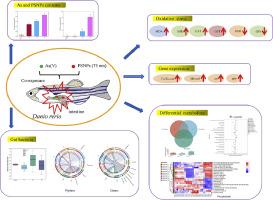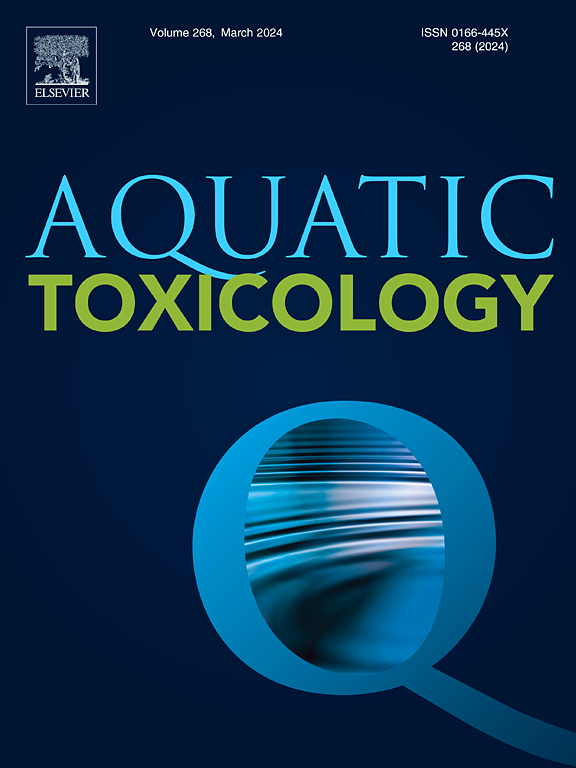生理学、微生物群和代谢组学的整合揭示了斑马鱼肠道对同时暴露于聚苯乙烯纳米塑料和砷的毒性反应
IF 4.1
2区 环境科学与生态学
Q1 MARINE & FRESHWATER BIOLOGY
引用次数: 0
摘要
纳米塑料(NP)颗粒和砷(As)都广泛存在于水生环境中,并对水生生物构成综合暴露风险。水生生物的肠道如何应对综合暴露风险仍不清楚。在这项研究中,斑马鱼(Danio rerio)通过半静态水传播暴露于三种不同的砷胁迫环境:仅砷组(10 μg/L)和砷与不同浓度的聚苯乙烯(PS)NPs(1 mg/L和10 mg/L)组,为期21天。研究人员对综合应激的生理反应、肠道微生物的多样性以及肠道的代谢组学反应进行了调查。研究结果表明,共同暴露组斑马鱼肠道中普遍存在 PSNPs。此外,与单独施用砷处理相比,在共同暴露组中施用 1 毫克/升和 10 毫克/升的 PSNPs 可使斑马鱼肠道中的砷含量分别升高 24.88% 和 76.95%。与单独暴露于 As 相比,肠道同时暴露于 PSNPs 和 As 会导致 MDA、SOD、CAT 和 GST 的含量/活性增加,而 GSH 和 GPx 的含量/活性降低。此外,联合暴露还导致 Cu/Zn-sod、Mn-sod、gpx 和 cat 基因的表达升高。氮氧化物和砷的联合处理导致门级的变形菌和镰刀菌丰度增加,以及属级的鲸杆菌、红球菌和乳杆菌丰度显著增加。非靶向代谢组学分析表明,受共同暴露影响的代谢途径包括甘油磷脂代谢、甘油酯代谢、ABC 转运体和自噬。这项研究的结果对于评估共存污染物的毒理学影响具有重要意义。本文章由计算机程序翻译,如有差异,请以英文原文为准。

Integration of physiology, microbiota and metabolomics reveals toxic response of zebrafish gut to co-exposure to polystyrene nanoplastics and arsenic
Both nanoplastic (NP) particles and arsenic (As) are widespread in aquatic environments and pose a combined risk of exposure to aquatic organisms. How the gut of aquatic organisms responds to combined risk of exposure is still unclear. In this study, zebrafish (Danio rerio) were subjected to three distinct As stress environments: only As group (10 μg/L), and As combined with different concentrations of polystyrene (PS) NPs (1 mg/L and 10 mg/L) groups for 21 days via semi-static waterborne exposure. The physiological responses to combined stress, the diversity of gut microorganisms, and the metabolomic response of the gut were investigated. The findings indicated that PSNPs were prevalent in the intestines of zebrafish in the co-exposed group. Furthermore, the administration of 1 mg/L and 10 mg/L of PSNPs in the co-exposed group was observed to elevate As levels in the intestines by 24.88% and 76.95%, respectively, in comparison to As treatment alone. Simultaneous exposure of the gut to PSNPs and As resulted in increased contents/activities of MDA, SOD, CAT, and GST, and a decrease in contents/activities of GSH and GPx, when compared to As exposure alone. Additionally, the combined exposure led to an elevated expression of the Cu/Zn-sod, Mn-sod, gpx, and cat genes. The combined treatment with NPs and As resulted in an increase in the abundance of Proteobacteria and Fusobacteriota at the phylum level, as well as a significant increase in the abundance of Cetobacterium, Rhodococcus, and Bacteroides at the genus level. Non-targeted metabolomics analyses suggest that metabolic pathways affected by co-exposure include glycerophospholipid metabolism, glycerolipid metabolism, ABC transporters and autophagy. The findings of this study are of considerable significance for the evaluation of the toxicological impact of co-existing pollutants.
求助全文
通过发布文献求助,成功后即可免费获取论文全文。
去求助
来源期刊

Aquatic Toxicology
环境科学-毒理学
CiteScore
7.10
自引率
4.40%
发文量
250
审稿时长
56 days
期刊介绍:
Aquatic Toxicology publishes significant contributions that increase the understanding of the impact of harmful substances (including natural and synthetic chemicals) on aquatic organisms and ecosystems.
Aquatic Toxicology considers both laboratory and field studies with a focus on marine/ freshwater environments. We strive to attract high quality original scientific papers, critical reviews and expert opinion papers in the following areas: Effects of harmful substances on molecular, cellular, sub-organismal, organismal, population, community, and ecosystem level; Toxic Mechanisms; Genetic disturbances, transgenerational effects, behavioral and adaptive responses; Impacts of harmful substances on structure, function of and services provided by aquatic ecosystems; Mixture toxicity assessment; Statistical approaches to predict exposure to and hazards of contaminants
The journal also considers manuscripts in other areas, such as the development of innovative concepts, approaches, and methodologies, which promote the wider application of toxicological datasets to the protection of aquatic environments and inform ecological risk assessments and decision making by relevant authorities.
 求助内容:
求助内容: 应助结果提醒方式:
应助结果提醒方式:


